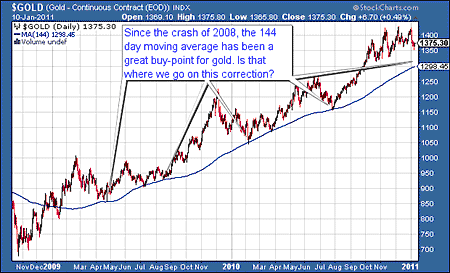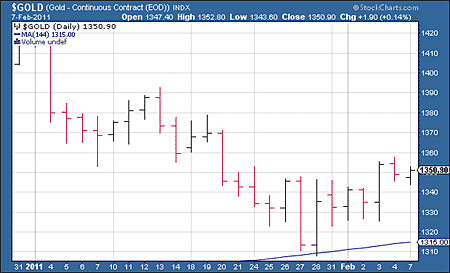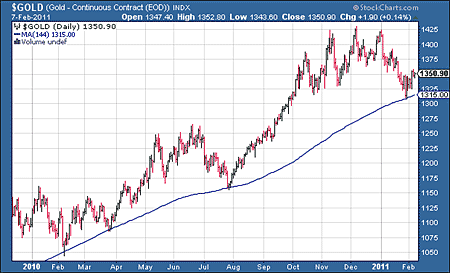Gold will hit $1,650 before the end of the year
The price of gold fell back in the first few weeks of 2011. But its bull run continues. And while there is likely to be more consolidation in the short term, says Dominic Frisby, there's every chance it will hit $1,650 an ounce by the end of the year.
Some people had been wondering if the recent correction in the gold price, which began at the New Year, was anything more than a normal bull market correction.
It appears that it wasn't.
The excessive bullish sentiment has been washed out. There is a proliferation of uninformed articles in the press and online, written by people who don't, and have never, owned gold, declaring that the bull market is over.
MoneyWeek
Subscribe to MoneyWeek today and get your first six magazine issues absolutely FREE

Sign up to Money Morning
Don't miss the latest investment and personal finances news, market analysis, plus money-saving tips with our free twice-daily newsletter
Don't miss the latest investment and personal finances news, market analysis, plus money-saving tips with our free twice-daily newsletter
Obscure European bankers have stopped calling for a return to the gold standard. And my Aunt Doris is no longer phoning me to ask about the mineralisation of some dodgy miner's drill core.
Yet we're still in a very nice uptrend.
So what next?
Gold has hit my January target
If you've been following my Money Mornings recently you will remember that I was looking for gold to return to its 144-day moving average its average price of the previous 144 days by late January: How low will gold go?
And on 28 January that's exactly what it did.
This was the chart that I posted.

And here, in close-up, is what happened next. This is gold in 2011. The blue line at the very bottom of the chart is the 144-day moving average.

Here's how that looks on a broader scale.

Finding an investment method that works for you
Why has it worked so well? I wish I knew. 144 is a Fibonacci number, of course, so that will have fans of The Da Vinci Code jumping up and down.
But I will say that these things work until they stop working. That might sound ridiculous, but in my experience, it appears that whatever trading and investment method you use from the sensible, plodding analysis of price to earnings ratios and book values, to the some-would-say lunatic (pun intended) analysis of planetary cycles strategies seem to work for a while, then for no apparent reason they stop. Then, just as mysteriously, they start working again.
You have to find a method that sits well with you. The down-to-earth look at earnings ratios, while the eccentric might look towards the stars. I happen to like moving averages and trend lines. And since the bust of 2008, the 144 has worked brilliantly for gold.
There will come a time when it stops working. When it does, I have to be man enough to recognise that and move on. Or if I'm that sure of my method, sit patiently and wait till it starts working again, just as a value investor waits for a company's 'true value' to be recognised.
The gold bull market is still on course
So what now? Gold only gave back 40% or so of its move from the summer lows. Silver was even stronger, yielding just 35%. Yet that's all it took to purge the markets of excessive bullish sentiment. I'd say that bodes extremely well for the longer-term bull market in precious metals.
Why? Because the closer you get to the end of a bull market, the harder it is to shake investors' conviction. If the bulls are still easily rattled by relatively small corrections, it's a healthy sign.
Here's one example of how excessive bullishness has been washed out. You may have heard that a hedge fund sold off a large gold futures position in recent weeks. According to reports, a $10 million fund was holding a position larger than the entire annual production of South Africa. Given the leverage these people use, it's no wonder there is so much volatility. (I don't know how they manage to sleep at night when they do that. You'd be better off buying an explorer but each to their own.)
This liquidation has seen the open interest on the Chicago Futures Exchange (the COT) shrink back to levels of summer 2009. (To be precise, the commercial traders' net short positions are at July 2009 levels and the non-commercials' net long positions are at May 2009 levels.)
What does this mean? The positions of the traders on the futures exchange are seen as a forerunner of the gold price. There are three sets of traders: the commercials, the large traders and the small speculators. Broadly speaking, the less open interest there is, the more bullish the set-up. And the fewer short positions (ie the fewer bets that the market will fall) that the commercial traders (who are seen as the 'smart money') have, the more bullish the set-up.
The logic of this is that the less open interest there is, the more potential buyers there are to enter the market. So the fact that open interest has fallen back to 2009 levels is very positive.
Of course, the COT data isn't an infallible indicator nothing is. And the proliferation of other means to invest in gold outside of the futures market, such as the exchange traded funds (ETFs), also brings into question just how representative the futures data is. But I still find the COT to be a useful indicator of market lows.
So what now for gold?
I must say I'm not wildly bullish in the short-term. In fact, I expect further consolidation. February is often a good month for precious metals. But March is not. We may well see a re-test of my notorious 144-day moving average then. I would expect silver to hit resistance in the $31-32 area , and we are not far off that now. Gold might struggle at $1,385 or even $1,420. I don't see new highs until later in the year.
I could well be wrong. And do you know what? I hope I am.
But in the longer run, the fact that so many are starting to doubt gold, even in the face of runaway inflation everywhere you look, has to be positive.
$1,650 before the end of 2011? I should say so.
Our recommended article for today
Five big financial surprises to prepare for
Every year, City economists and strategists outline their big themes for the months ahead. But what makes life interesting are the things no one was expecting. Matthew Lynn picks five surprises to watch out for.
Get the latest financial news, insights and expert analysis from our award-winning MoneyWeek team, to help you understand what really matters when it comes to your finances.
MoneyWeek is written by a team of experienced and award-winning journalists, plus expert columnists. As well as daily digital news and features, MoneyWeek also publishes a weekly magazine, covering investing and personal finance. From share tips, pensions, gold to practical investment tips - we provide a round-up to help you make money and keep it.
-
 8 of the best properties for sale with indoor gyms
8 of the best properties for sale with indoor gymsThe best properties for sale with indoor gyms – from a four-storey mews house in London’s Knightsbridge, to a 1920s Arts & Crafts house in Melbury Abbas, Dorset
-
 Top stock ideas for 2026 that offer solidity and growth
Top stock ideas for 2026 that offer solidity and growthLast year’s stock ideas from MoneyWeek’s columnist and trader, Michael Taylor, produced another strong performance. This year’s stocks look promising too

